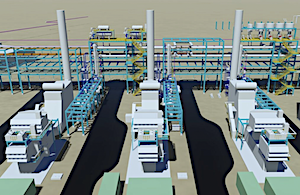Essar Energy Transition (EET) announced the launch of EET Hydrogen Power, Europe’s first hydrogen-ready combined heat and power plant (CHP) to be built at its Stanlow refinery in Ellesmere Port on the Mersey, with the aim of completing construction in 2027.
The investment is a key part of EET’s overall $3 billion of energy transition initiatives in the North West of England.
“The investment will support EET Fuels’ ambition to become the lowest carbon process refinery, globally and EET Hydrogen’s ambition to become the leading low carbon hydrogen producer in the UK,” said EET.
“It will also provide low carbon power to other industrial users in the region to support their decarbonisation targets. EET Hydrogen Power will become an independent vertical under EET.
“EET Hydrogen Power will be developed over two phases to reach a capacity of 125 MW of power with 6,000 tonnes per day of steam, with the hydrogen replacing hydrocarbons delivering a reduction of 740,000 tonnes of carbon dioxide per annum.
“The new plant will replace Stanlow’s existing boiler units, which currently generate approximately 50MW of power for the refinery operations. The plant is integral to the decarbonisation of operations at EET Fuels’ Stanlow refinery, which plans to cut total emissions by 95% by 2030, to become the world’s lowest carbon refinery.”
Essar Energy Transition Managing Partner Tony Fountain said: “Launching EET Hydrogen Power shows the progress that Essar Energy Transition is making in delivering against its commitment to put the UK at the forefront of low carbon energy.
“EET Hydrogen Power helps bring this commitment to life and demonstrates our intention to globally showcase the pathway to decarbonising vital high emitting industries.”
EET Hydrogen Power CEO Rob Wallace said: “We have bold ambitions for Stanlow to become a low carbon transition hub at the centre of the HyNet Industrial Cluster.
“EET Hydrogen Power will be Europe’s first 100% hydrogen-ready gas-turbine plant which will be supplied with EET Hydrogen’s low carbon hydrogen. This project will create significant benefit by contributing to regional emissions’ reductions targets.”
